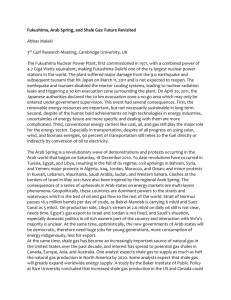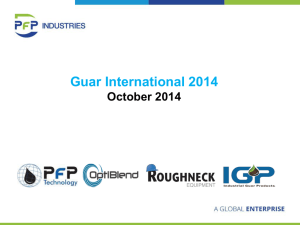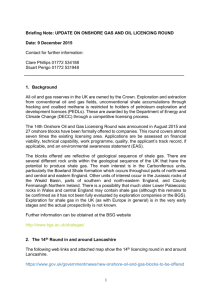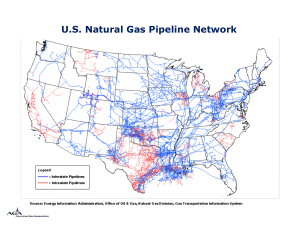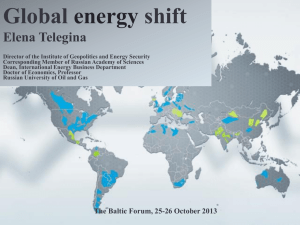Gas NMR Characterization of Oil Shale
advertisement
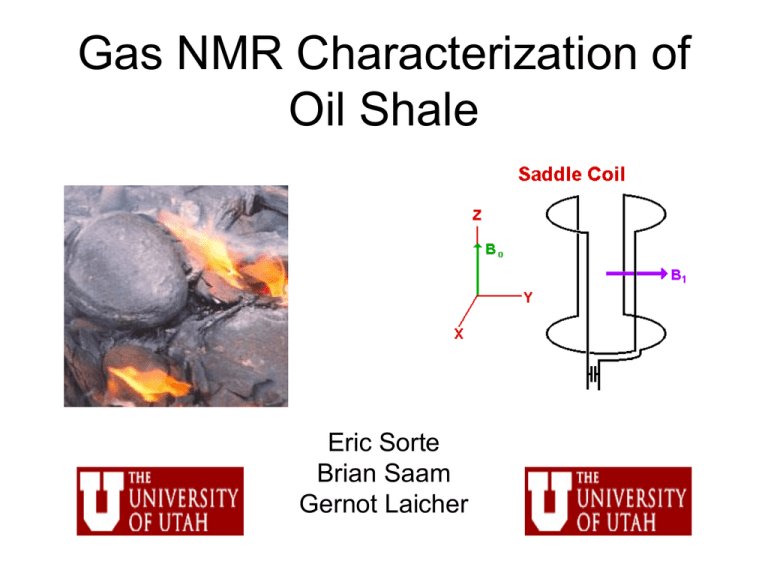
Gas NMR Characterization of Oil Shale Eric Sorte Brian Saam Gernot Laicher Oil Shale Fine sedimentary rock, contain kerogens Estimated 2 trillion barrels of oil in shale reserves in Wyoming, Utah, Colorado ~ 400 year supply Extraction of oil involves pressurized pyrolysis and/or solvent processes of reactive chemicals Research goes back more than a century *According to a survey conducted by the RAND Corporation, “…[crude oil extraction] is unlikely to be profitable unless crude oil prices range between US$70 to US$95 per barrel.”* * Bartis, James T. (2005). "Oil Shale Development in the United States. Prospects and Policy Issues. Prepared for the National Energy Technology Laboratory of the U.S. Department of Energy”. The RAND Corporation. ISBN 978-0-8330-3848-7 Retrieved on 2007-06-29. Why Study Oil Shale • Pore size/structure of interest • Characterize rock at each stage of chemical treatment, sequentially removing internal matrix and revealing structure • Changes of porosity/structure as function of pressure and temperature OUTLINE I. NMR Overview II. Gas Diffusion NMR vs. Traditional NMR III. Experimental Setup/Procedure IV. What’s Next Nuclear Magnetic Resonance (NMR) N S V Polarization (I = ½): = ħI H = - • B = - ħIz Bz E = ħL where L = Bz E T1 Processes In equilibrium, magnetization lies along z-axis ** It is possible to change the net magnetization by exposing the nuclear spin system to energy of a frequency equal to the energy difference between the spin states. B1 Spin recovers with time constant T1 Mz = Mo ( 1 - exp(-t/T1 ) ) We can characterize porosity, permeability, tortuosity, and surface to volume ratios once we know T1 - R.L. Walsworth - Dean O. Kuethe Why Gas Diffusion NMR? Problem Low densities lead to weak signals Solutions and advantages - Weak signal overcome by multiple spins per atoms (C2F6) - Inert fluorinated gases have very short relaxation times (signal avg.) - Densities ~ 1000 lower than liquids allow exploration of small porous regime where diffusive displacement is on order of pore size - Shale in situ is pressure fractured with CO2 - Hyperpolarized noble gases Experimental Setup V Spoon Vcal Imaging Superconducting Magnet V Freeze chamber V V V Probe Oil shale Liquid nitrogen bath C2F6 What’s Next Diffusivity studies on raw shale Characterize rock at each stage of chemical treatment, sequentially removing internal matrix and revealing structure Determine pressure, temperature dependence Understand fluid flow in shale under different conditions ** Find simple, cheap, low-impact method of in-situ kerogen extraction for conversion to oil** NMR Imaging T=xB • Precession Frequency Determined by Nucleus and Magnetic Field L = Bz Pressure Probe and Circuitry Circuit to match and tune coil to maximize signal







